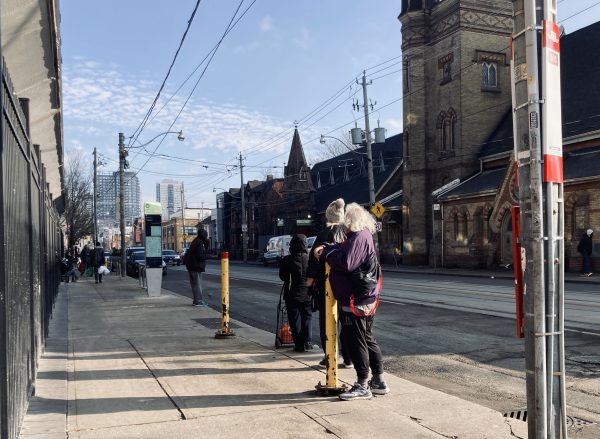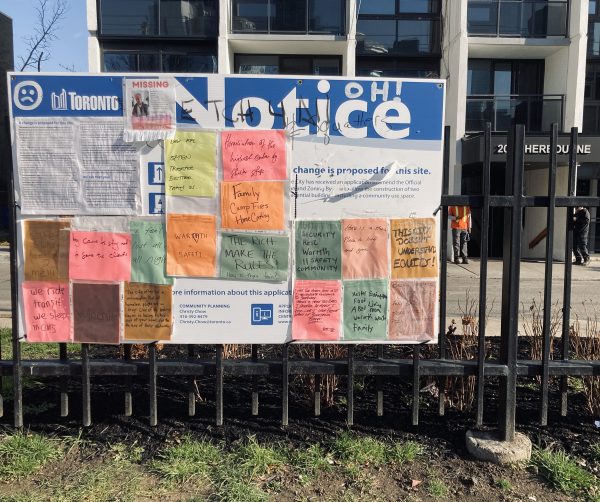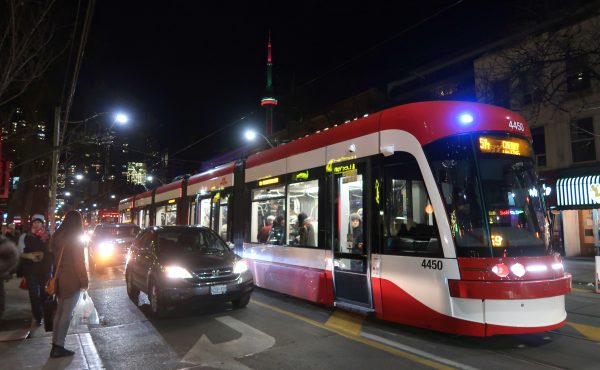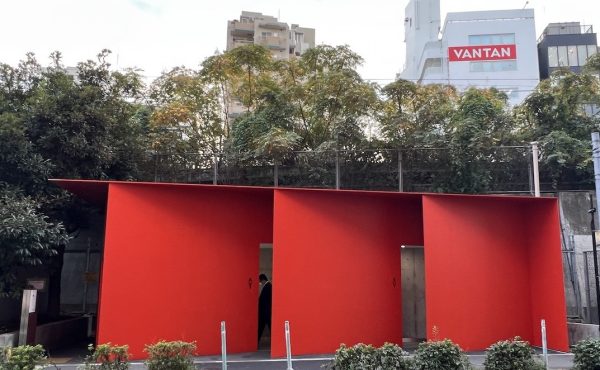During the week of December 2, 2023, the City of Toronto removed a TTC transit shelter at Dundas Street East and Sherbourne Street, in Moss Park. The removal, carried out by the street furniture division, was made at the direction of Toronto-Centre councillor Chris Moise.
Lorraine Lam, a local outreach worker, arrived just in time to bear witness. She watched as a truck with a crane parked nearby. A man in a high-visibility vest made sure no one was in the way as the crane’s hooks latched on to the last glass panel of the shelter and lifted it onto the flatbed. She knew there were people who were asking for the shelter to be removed but didn’t think it would actually happen.
“I think a lot about what public infrastructure says about our values and who belongs,” said Lam. “It’s very clear which voices are listened to. Because whoever they consulted about [removing] this shelter, it was not the people that are using it the most.”
Public space is a stage for the consequences of political dissonance, and a strong, but struggling neighbourhood like Moss Park bears the brunt of the conflict. This transit shelter stood at an intersection, not just physically, but also socially and politically. It was where many of the issues the city is grappling with have come to a head.
In lieu of safe drug consumption sites, affordable housing, and adequate shelter space, transit shelters have become a refuge for people trying to survive, especially as the weather gets colder.
In the month before the shelter was removed, councillor Moise and deputy mayor Ausma Malik presented the City’s five-year mental health and harm reduction strategy, underscoring that addiction should not be criminalized. Moise sits on the Toronto Transit Commission Board and Board of Health.
After the shelter removal, Moise appeared on 640 Radio to talk about the decision. “There were four shootings earlier this year in the corridor,” he said. “There’s a lot of people selling drugs in the area. People were using [the shelter] to shoot up. It’s not safe, we knew that… the bus shelter was the problem.”
Moise’s office has not responded to Spacing’s request for comment. But in an email response to a constituent, a staff member stated that the decision was made after a consultation with “community, staff, Toronto Police and a Crime Prevention Through Environmental Design (CPTED) Audit.”
“People who are bitching on social media [about the removal] are misinformed and don’t have all the facts,” Moise said during the radio interview.
Here, then, are the facts.

The structure
The bus shelter in question was located on the west side of Dundas East at Sherbourne. It was a canopy-style shelter installed and maintained by Astral Media, through a partnership the company negotiated with the City in 2007. In a statement to Spacing, a City spokesperson said removal of the transit shelter was to “maintain public safety and accessibility.” In total, four transit shelters have been removed since 2022.
But that transit stop services the busy 505 Dundas streetcar and without a shelter, usage becomes more difficult for some people, explains Adam Cohoon, who is the accessibility co-chair for TTCriders as well as a Moss Park resident who lives with a neurological disability and uses a wheelchair.
“This is a hostile move,” says Cohoon. “It’s a message. They haven’t taken away the actual stop, but in a way, they have, because now only the healthiest people can use it.”
Many of the transit users who frequent that stop are seniors or folks who live with disabilities. Two public housing complexes, including one for seniors, are close by. TTCriders advised that Council should add services and infrastructure to support community needs as “taking away public transit infrastructure to address public safety concerns is the wrong approach.”
The Location
The shelter was situated in an area that is “home to many of the city’s most marginalised residents,” according to the 2023 Downtown East Action Plan (DEAP). The DEAP was adopted by council in 2019 to address challenges affecting the people who live in the area, such poverty, homelessness, substance use, violence and mental illness.
Organizations nearby were established to support these residents. Across from the shelter is All Saints-Church and Community Centre, which offers drop-in programs for meals, emergency clothing and nursing care. Just a little further east is Street Health Toronto, an overdose prevention site and low-barrier, drop-in health centre. Street Health was not consulted before the decision to remove the bus shelter was made, according to executive director Lin Sallay.
Substance use
There are people who live in the area who use substances. Street Health, located east of the transit shelter, is a non-profit organization working to address the drug toxicity crisis in Toronto through a harm reduction approach. It offers nursing services and supplies for substance abuse, as well as a hygienic, safe and non-judgmental space for people to consume substances while supervised by medical professionals.
Outreach workers at Street Health say the removal does not follow a harm reduction approach. Rather, it creates a disconnection between its services and clients, as the shelter served as a point of contact.
“If the community has concerns about safety, we are also concerned, because that is our agency’s priority. We advocate for people who are struggling and going through difficult situations,” says Chaudhry Ahmed, a harm reduction manager at Street Health. Another outreach worker said, “the transit shelter saves lives.”
Street Health is funded by the municipal and federal government, other agencies and charitable donations. However, it receives more funding from donations than from the government. Street Health has seen a 37% decrease in public funding since 2021.
When the site is busy, or closed after hours, where else can people safely consume drugs? The transit shelter acted as an impromptu drug consumption site. The other overdose prevention site that once existed two blocks south, at 134 Sherbourne St., was shut down. An application for redeveloping that site into a 45-storey mixed-use building awaits approval from the city council.
Homelessness and the housing crisis
That property is not the only one slated for redevelopment in Moss Park. Several seek to flip properties into rental buildings. But this kind of housing is a commodity not everyone can afford.
“People who are sleeping rough are doing whatever they need to in order to survive,” says Lam. “For a number of people, it’s sleeping in a [transit] shelter, because it protects them from the elements.”
Some people have frozen to death sleeping in transit shelters near the Moss Park neighbourhood. On Feb. 4, 2023, a person died from hypothermia in a transit shelter near Sherbourne and Shuter streets.
Paige, who identifies as Two-Spirit, is struggling to find a shelter bed and stopped by Street Health for help to find one. They spent much of November and December sleeping outside. Paige often rests in the transit shelter at Dundas and Sherbourne to take their insulin injections. “[The City] doesn’t care who they go displacing,” said Paige. “Or that they’re pushing that person with an addiction further away in harm’s way to use by themselves, or in a secluded place.”
The creation of new supportive housing is needed to address the homelessness crisis and addiction, as the City’s own action plan affirms. But when the City tried to acquire properties at 214-230 Sherbourne St. in March 2022 for precisely that purpose, a private real estate corporation outbid them. KingSett Capital purchased the property for $52 million. They’re looking to construct a 47-storey tower with 66 below ground parking spaces. The zoning application still has to be approved by the City.
Gun violence
Gun violence is also another issue that affects the area around the transit shelter. On Sept. 16 2023, Kyle Provo, 33, who worked at a Caribbean restaurant near the shelter, according to a community member, was allegedly shot by two other men. He died in hospital.
A study completed by the Samuel Centre for Social Connectedness in partnership with the City outlines the systemic causes for gun violence, which disproportionately affects young Black men, such as poverty and economic inequity. This research does not suggest policing as an effective solution. Instead, it states that gun violence can be considered a health equity issue, and as such, requires a public health-orientated response. Instead, according to an email from Moise’s staff, the councillor consulted the Toronto Police Service’s CPTED audit, which recommended removing the shelter.
When I visited the site in December, the empty spot where the transit shelter once stood was illuminated by afternoon light. An individual with long grey hair leaned against a yellow metal bollard installed after the removal, hoping to see the next streetcar coming down the stretch of Dundas before it arrives .
The City says there are no immediate plans to re-install the transit shelter.
Daysha Loppie is a journalist based in Toronto. Her work has been published by the Toronto Star, West End Phoenix, ByBlacks and more.





6 comments
Another question countered with the reply of “Why should we solve the problems when we can inflict more misery instead?”
TTC removed a bus stop at 250 Davenport Rd without any consultation with the community being affected. a TCHC high-rise with almost a 1000 residents living there
They didn’t give a crap that people with mobility and vision issues now had to walk down to the corner.
Our Councillor didn’t give a hoot, and as much said so in an email reply to us.
We managed to make a deputation to the TTC Board of Directors only to have one of them condescendingly accuse us of acting as though we should receive special treatment, as though the needs of 1000 low-income people didn’t count.
WOKE NONSENSE… The city did a good job and youre whining?
In the interests of accuracy: the shelter in question served the westbound 505 Dundas streetcar route and was located on the NE corner of Dundas/Sherbourne. It was not “located on the west side of Dundas East at Sherbourne” . That fact is evident in the photo of the bollards which clearly shows the church across the street which is on the SE corner.
We don’t need a Ward wide plebiscite to gauge support for removing TTC bus shelters, however, some level of engagement with non-profit agency partners in the Dundas/Sherbourne area would have been the right thing to do. At the same time, I wonder what degree of consultation would have been considered agreeable by the same agency partners/outreach workers.
Sanctimonious statements like “the transit shelter saves lives” would do little to further dialogue about why there was a need to remove the bus shelter. Councillor Moise did not act on this alone. His office was effectively lobbied by legitimate stakeholders in the Dundas/Sherbourne community. This included residents from the nearby senior’s TCH building – who by the way, use the transit stop. The reasons for why these stakeholder groups wanted the removal of the bus shelter should have been elaborated in this article.
As a longstanding advocate and community leader, the residents in this neighbourhood are thrilled to see this bus shelter go. The author notes it was used regularly as an impromptu unsupervised drug consumption site. This is why it was removed. Needles and other hazardous waste filled the shelter around the clock, making it unsafe for anyone passing by or waiting on the corner for the streetcar. This signals one small step forward in making this intersection safe for everyone.